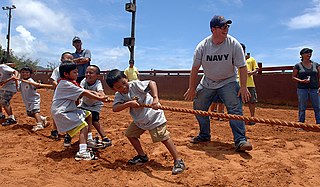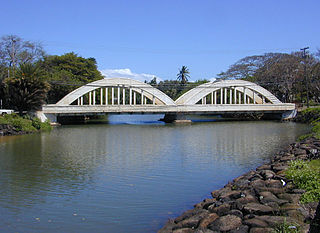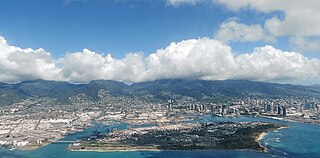
Honolulu is the capital and largest city of the U.S. state of Hawaii, which is in the Pacific Ocean. It is an unincorporated county seat of the consolidated City and County of Honolulu, situated along the southeast coast of the island of Oʻahu, and is the westernmost and southernmost major U.S. city. Honolulu is Hawaii's main gateway to the world. It is also a major hub for business, finance, hospitality, and military defense in both the state and Oceania. The city is characterized by a mix of various Asian, Western, and Pacific cultures, reflected in its diverse demography, cuisine, and traditions.

Oahu, also known as "The Gathering Place", is the third-largest of the Hawaiian Islands. It is home to roughly one million people—over two-thirds of the population of the U.S. state of Hawaii. The island of O’ahu and the Northwestern Hawaiian Islands constitute the City and County of Honolulu. The state capital, Honolulu, is on Oʻahu's southeast coast. Oʻahu had a population of 1,016,508 according to the 2020 U.S. Census, up from 953,207 people in 2010.

Scouting in Hawaii began in the 1900s. It serves thousands of youth in programs that suit the environment in which they live.

Haleʻiwa is a North Shore community and census-designated place (CDP) in the Waialua District of the island of Oʻahu, City and County of Honolulu. Haleʻiwa is located on Waialua Bay, the mouth of Anahulu Stream. A small boat harbor is located here, and the shore of the bay is surrounded by Haleʻiwa Beach Park and Haleʻiwa Aliʻi Beach Park. Further west from the center of town is Kaiaka State Recreation Area on Kiaka Point beside Kaiaka Bay. As of the 2020 census, the CDP had a population of 4,941. The 2018 estimate was 4,040. It is the largest commercial center on the North Shore of the island. Its old plantation town character is preserved in many of the buildings, making this a popular destination for tourists and residents alike, visiting surfing and diving sites along the north shore.

Kahuku is a census-designated place (CDP) in Honolulu, Hawaii, United States. In the Hawaiian language, ka huku means "the projection", presumably a reference to Kahuku Point nearby, the northernmost point of land on the island of Oahu. As of the 2010 Census, Kahuku had a population of 2,614.

Kawela Bay is a census-designated place and small community in the Koʻolauloa District on the northern coast of the island of Oʻahu, City & County of Honolulu, Hawaii, United States. In Hawaiian, ka wela means "the heat". As of the 2020 census, the CDP had a population of 325.

Waikāne or Waikane, also known as North Koʻolaupoko, is an area and census-designated place in the County of Honolulu, Hawaii, United States, on the island of Oʻahu. It had a population of 778 at the 2010 census. In Hawaiian, koʻolau poko means "short windward", referring to the fact that this is the shorter of the two windward districts on the island. Koʻolaupoko extends from Makapuʻu Point on the southeast to Kaʻōʻio Point on the north. Included within the district, south of North Koʻolaupoko, are the largest windward towns of Kāneʻohe, Kailua, and Waimānalo.

Kaʻena or Kaena Point is the westernmost tip of land on the island of Oʻahu. In Hawaiian, kaʻena means 'the heat'. The area was named after a brother or cousin of Pele. The point is designated as a Natural Area Reserve. Some ancient Hawaiian folklore states that Kaʻena Point is the "jumping-off" point for souls leaving this world.

Gerrit Parmele Judd was an American physician and missionary to the Kingdom of Hawaii who later renounced his American citizenship and became a trusted advisor and cabinet minister to King Kamehameha III.

Honolulu Harbor, also called Kulolia and Ke Awa O Kou and the Port of Honolulu, is the principal seaport of Honolulu and the State of Hawaiʻi in the United States. From the harbor, the City & County of Honolulu was developed and urbanized, in an outward fashion, over the course of the modern history of the island of Oahu. It includes Matson, Inc. harbors on Sand Island.
The following is an alphabetical list of articles related to the U.S. state of Hawaii:

The Oahu Railway and Land Company, or OR&L, was a 3 ft narrow gauge common carrier railway that served much of the Hawaiian island of Oahu, and was the largest narrow gauge class one common carrier in the U.S, until its dissolution in 1947.

Kualoa is a 4,000-acre (1,600 ha) private nature reserve and working cattle ranch, as well as a popular tourist attraction and filming location on the windward coast of Oʻahu in Hawaiʻi. It is about 24 miles (39 km) from Honolulu, and 32 miles (51 km) from Haleiwa. The ranch consists of 3 valleys: Kaʻaʻawa Valley, Kualoa Valley, and Hakipuʻu Valley. The ranch is located on Hawaii State Route 83 between Kaʻaʻawa and Waikane. The main street address is 49-560 Kamehameha Highway, Kāneʻohe, Hawaiʻi 96744.
The Turtle Bay Resort is a resort with cottages on the North Shore of Oahu island in Hawaii.

Honolulu County is a consolidated city–county in the U.S. state of Hawaii. The city–county includes both the city of Honolulu and the rest of the island of Oʻahu, as well as several minor outlying islands, including all of the Northwestern Hawaiian Islands except Midway Atoll.

Ulupō Heiau on the eastern edge of Kawai Nui Marsh in Kailua, Hawaiʻi, is an ancient site associated in legend with the menehune, but later with high chiefs of Oʻahu, such as Kakuhihewa in the 15th century and Kualiʻi in the late 17th century. It may have reached the peak of its importance in 1750, before being abandoned after Oʻahu was conquered in the 1780s. The site became a territorial park in 1954, was partially restored in the early 1960s, marked with a bronze plaque by the State Commission on Historical Sites in 1962, and listed on the National Register of Historic Places in 1972.

The North Shore, in the context of geography of the Island of Oʻahu, refers to the north-facing coastal area of Oʻahu between Kaʻena Point and Kahuku. The largest settlement is Haleʻiwa.

Colonel Charles Hastings Judd was a Hawaiian businessman, rancher, courtier and politician who was born, lived, worked and died in the Kingdom of Hawaii. He served as chamberlain and colonel of the military staff of King Kalākaua and traveled with the monarch on his 1881 world tour.
The Hawaiian Legacy Reforestation Initiative (HLRI) is a Hawaii-based 501(c)(3) nonprofit organization founded in 2014 that works to reforest endemic trees and restore native habitat for wildlife. This includes koa, ‘ōhi‘a, māmane, naio, ko‘oko‘olau, kūkaenēnē and ‘iliahi trees.
The March 2021 Hawaii floods was a devastating series of floods that caused a tremendous amount of damage to the U.S state of Hawaii. The heavy rain started on March 7, 2021, and flooded the Kaupakalua Dam. It was reported that the dam flooded due to deficiencies, and as a result, it is set to be decommissioned this summer. One person is currently missing from the floods, and at least a half dozen homes were heavily damaged or destroyed in the flooding, which also destroyed Peahi Bridge and heavily damaged Kaupakalua Bridge. More than 1,300 customers in Haiku were without power at 6:30 a.m. Tuesday HST.



















